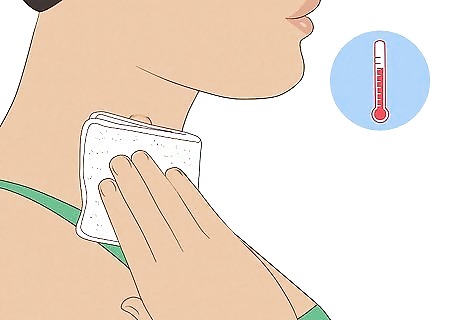
views
X
Trustworthy Source
Mayo Clinic
Educational website from one of the world's leading hospitals
Go to source
You can get the cyst medically removed by a doctor or use home treatments to encourage the cyst to heal and disappear.
Getting the Cyst Medically Removed

Note if the cyst has become inflamed and irritated. Most sebaceous cysts are harmless and do not require treatment. But if the cyst becomes irritated or inflamed, you may consider going to your doctor so they can remove it for you safely. Check if there is a tiny blackhead in the center of the cyst. The cyst may also be red, inflamed, and tender. You should also note a thick yellow fluid that comes out of the cyst when you press on it. The fluid may have a foul smell.

Let your doctor examine the cyst. If you think the sebaceous cyst is infected, allow your doctor to examine it and avoid touching it or draining it on your own at home. Trying to drain the cyst at home can increase your risk of having the cyst appear again, as you will not be able to remove the sac completely. Draining the sac on your own also increases your risk of infection and scarring in the area around the cyst.

Allow your doctor to drain the cyst. This is a fairly easy procedure and can be done in your doctor’s office. They will first apply a local anesthetic to the cyst so you do not feel the procedure. Then, they will make a small incision in the cyst and drain the contents by “expressing” the fluid. “Expressing” means they will apply a small amount of pressure on the cyst to push the fluid out. The fluid in the cyst may appear yellow or cheesy looking and have an unpleasant smell. Your doctor may also remove the cyst wall to prevent the cyst from appearing again. This is considered minor surgery and your doctor may need to give the area sutures once the cyst wall has been removed, depending on how big the cyst is. Removing the cyst is generally done after the acute infection has subsided to prevent recurrence of an infected cyst.

Make sure the area around the removed cyst does not get infected. Your doctor will give you instructions on how to treat the area around the removed cyst so it stays clean and does not get infected. They’ll also put a bandage over the removed cyst wound so it can heal and instruct you to apply over-the-counter ointment to keep the area clean.
Doing Home Treatments on the Cyst

Apply aloe vera gel to the cyst. Astringent herbs like aloe vera can be used to “pull out” the protein keratin, sebum, and other fluids in the cyst. After applying the aloe vera, rinse the area with warm water. Do this three to four times a day. Alternatively, apply castor oil in the same manner, repeating the application three to four times a day.

Apply apple cider vinegar to help dry out the cyst. If you are sensitive to apple cider vinegar, dilute it with an equal amount of water. Apply the vinegar three to four times a day.

Use dry burdock root to draw out the proteins in the cyst. Combine ½ teaspoon of dried burdock root with 1 tablespoon of honey and apply the mixture directly to the cyst three to four times a day.

Apply chamomile tea to the cyst. Chamomile is known to promote healing. Soak a bag of chamomile tea and then apply the warm bag directly to the cyst three to four times a day.

Use bloodroot on the cyst. Bloodroot is used in Native American medicine to treat skin disorders, including cysts. Mix ⅛ teaspoon of bloodroot powder with 2 tablespoons of castor oil and apply it to the cyst with a Q-tip. Only use a small amount of bloodroot on skin with no breaks or cuts. Do not swallow any bloodroot or use it around your eyes, mouth, or genital area.

Apply a warm compress to the cyst. Use a clean washcloth soaked in warm water on the cyst. Apply the warm compress at least four times a day for 10 minutes at a time. Alternatively, soak the washcloth in a mixture of ½ cup of water and ½ cup of chamomile tea steeped for 10 minutes, then apply it to the cyst. Or, soak the washcloth in diluted apple cider vinegar. Boil equal amounts of apple cider vinegar and water, then apply it to the cyst.

















Comments
0 comment